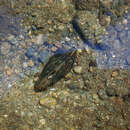zh-TW
在導航的名稱


Mussels in general are responsive to tactile and chemical stimulation. Many sensory organs are on the middle lobe of the mantle edge. In the foot, mussels have paired statocysts, fluid filled chambers with a solid granule or pellet. The mussels use the statocysts to orient themselves.
Unionids in general may have some form of chemical reception to recognize fish hosts.
Glochidia respond to both touch, light and some chemical cues. In general, when touched or a fluid is introduced, they will respond by clamping shut.
Communication Channels: chemical
Perception Channels: tactile ; vibrations ; chemical
The dwarf wedgemussel, Alasmidonta heterodon, was list as federally endangered on March 14, 1990. The dwarf wedgemussel was added to the federally endangered list primarily because of human impacts on its habitat and water quality. Some factors include: agriculture, construction, pollution, silt deposits, low oxygen levels, water level fluctuation, temperature fluctuations, flooding, erosion, and siltation.
US Federal List: endangered
CITES: no special status
State of Michigan List: no special status
Dwarf wedgemussel females carry eggs in their gills and receive sperm (released from males) through the gills. After eggs have been fertilized, they develop into parasitic bivalved larvae called glochidia. The time needed to develop from fertilized eggs to glochia is unknown. The newly formed glochidia are released from the female and into the water where they need to attach to a host fish to survive. The glochidia develop into juveniles while attached to a host. After metamorphosis, a juvenile mussel will be sloughed from its host, where it further develops on the stream/river bottom.
The parasitic larvae have been found to metamorphose on the following host species: mottled sculpin, tessellated darter, and johnny darter.
Development - Life Cycle: metamorphosis
There are currently no known adverse effects of the dwarf wedgemussel on humans.
Freshwater mussels in general are important water quality indicator for streams and rivers.
Positive Impacts: research and education
Freshwater mussels in general occupy many tropic guilds by feeding on detritous. The mussels may also aid in the biodegradation of plant matter.
Ecosystem Impact: parasite
Species Used as Host:
The glochidia of the species are parasitic on its fish host. Once an adult, the dwarf wedgemussel is a filter feeder, feeding on phytoplankton and detritous.
Plant Foods: phytoplankton
Other Foods: detritus
Foraging Behavior: filter-feeding
Primary Diet: planktivore ; detritivore
The dwarf wedgemussel, Alasmidonta heterodon, has a discontinuous range on the Atlantic coast of the United States. Twenty-four populations of dwarf wedgemussels are found within 12 states from Maine to North Carolina. This species may have occurred in Canada but is likely extirpated.
Biogeographic Regions: nearctic (Native )
Dwarf wedgemussels are usually found in waters with slow to moderate current that have muddy sand to sand and gravel substrate.
Habitat Regions: freshwater
Aquatic Biomes: rivers and streams
The average lifespan of a dwarf wedgemussel is approximately 15 years.
Average lifespan
Status: wild: 15 years.
This freshwater mussel has a trapezoidal shell usually less than 45 mm long and 25 mm high. The anterior end of the shell is thick and the posterior end is usually thinner. The periostracum, or the outer layer of the shell, is a brown color. In juveniles reddish brown colored rays of differing widths are visible. The most distinguishing characteristic of this species is the hinge teeth, with the right valve having two and the left having only one. These mussels are slightly sexually dimorphic, with the female shell swollen posteriorly and more trapezoidal than the male, and the male shell being more compressed, ovate and elongated.
Average length: 45 mm.
Other Physical Features: ectothermic ; heterothermic ; bilateral symmetry
Sexual Dimorphism: sexes shaped differently
Young dwarf wedgemussels are often consumed by birds, such as ducks and herons. Young mussels are also eaten by fish. Mature dwarf wedgemussels can be consumed by some mammals, such as raccoons and muskrats.
Known Predators:
This species is a long term brooder that spawns in late summer. The male releases sperm out into the water, which float down stream and enter the females gills for fertilization. Females can receive sperm from multiple males. The resulting glochidia are then released by the female into the water.
Mating System: polygynandrous (promiscuous)
The dwarf wedgemussel is a long term brooder that spawns in late summer and then becomes gravid in the fall and releases the glochidia anywhere from late March to early June. Starting around August, the males release their sperm into the water which is then carried towards the females. The females take the sperm in through their gills and they fertilize the eggs. Once fertilized, the eggs are held in the marsupia of the female which becomes swollen and dark when occupied. The eggs are held in the marsupia and recieve parental care through the winter until they are ready to be released as glochida anywhere from March to June.
Breeding interval: The dwarf wedgemussel spawns once a year.
Breeding season: Males release sperm into the water around August.
Average gestation period: 8.5 months.
Key Reproductive Features: iteroparous ; seasonal breeding ; gonochoric/gonochoristic/dioecious (sexes separate); sexual ; fertilization (Internal )
Females brood fertilized eggs in the marsupia from seven to 10 months. The larvae (glochidia) are released in the spring.
Parental Investment: pre-fertilization (Provisioning); pre-hatching/birth (Provisioning: Female, Protecting: Female)